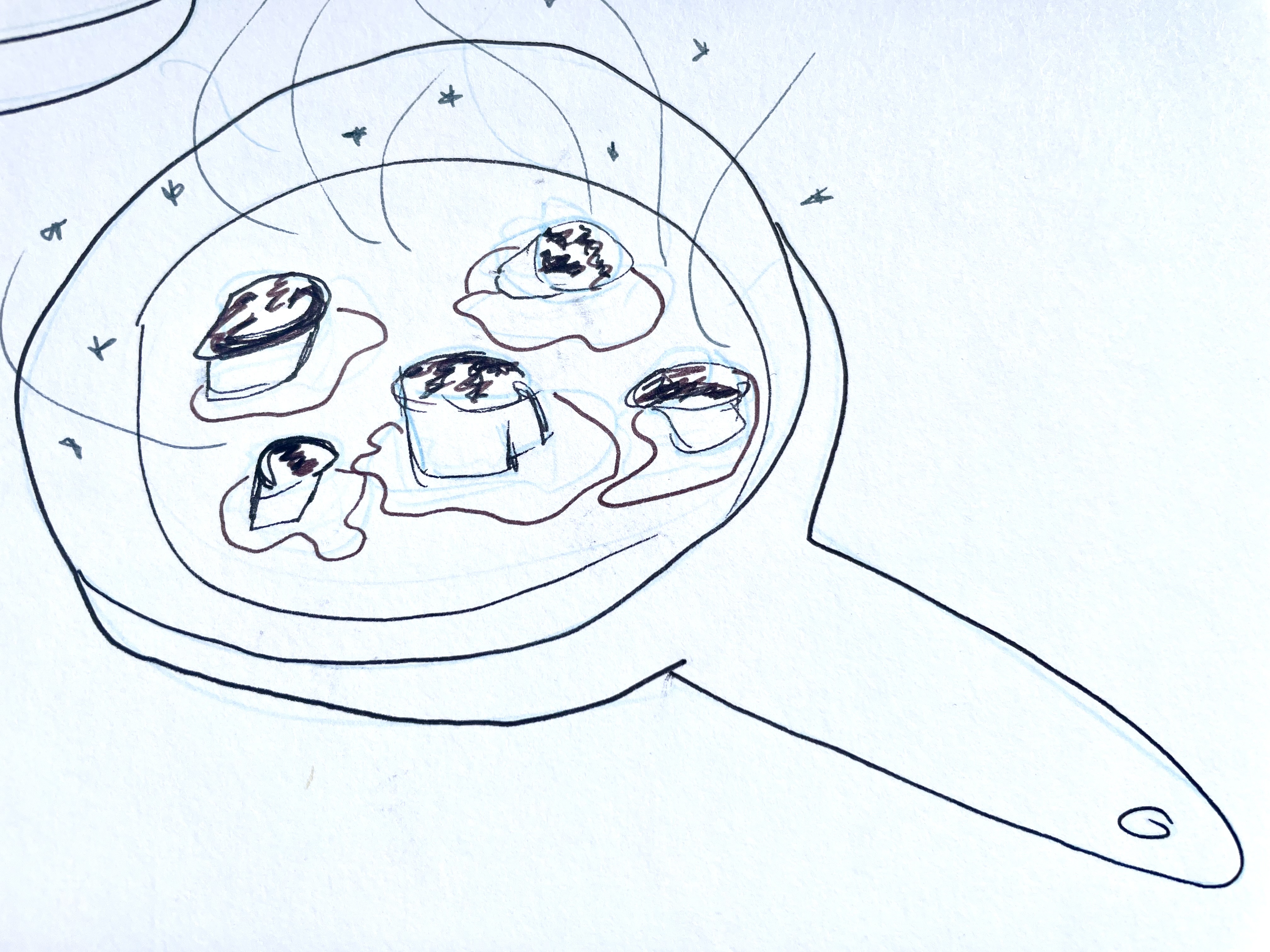Seared Scallops
← Recipes

inspired by an Island Creek Oysters marketing email from sometime between 2019-2020
Ingredients (for two servings)
- 1/2 pound dry sea scallops (every element of this is important. You do not want scallops that aren’t dry - that means they were treated with some solution to make them heavier so they won’t sear and you’re getting shit on price per pound - and you do not want bay scallops because they’re too tiny to be worth a damn. You don’t want more than this amount unless you have more people because they’re not good leftover.)
- unsalted butter (or, I guess you could use salted butter and not add salt to the scallops)
- salt, pepper
- garlic powder (optional)
Directions
- Take your scallops out of the fridge a couple hours before you want to eat.
- Go on and take the muscly part off the side and give them to your cat(s).
- Place the scallops on paper towels.
- Wait a couple of hours - you want them to be totally room temperature. If you’re making anything else to go with these, get those almost totally done before you start the scallops.
- When you’re ready for dinner, start heating a cast iron skillet on high. You want this to be big enough to space out the scallops so you don’t steam them vs. sear them.
- At this point, make sure both sides of the scallops are dry. Pick out which side looks biggest and have that facing up on the paper towel.
- When a few minutes have passed and the pan is real hot, maybe even smoking a little, throw a tablespoon or so of butter on it - just put enough to really cover the pan but won’t drown the scallops.
- Season your big-side-up scallops with salt and pepper. Garlic powder is a nice addition but it isn’t necessary.
- Once the butter is browning a little, place the scallops on the pan big side down and space them out well.
- Season the smaller sides that are now facing up.
- Watch the pan. A few minutes will pass. Can you see the scallops starting to cook up the sides? Don’t let it get past halfway! Flip those suckers (preferably the smaller ones first).
- You can time this next part - just one minute on the other side.
- Take them off the heat ASAP!
- If you’re feeling fancy, you could deglaze the pan with some white wine and pour the sauce you make on the plated scallops.
Thoughts
If you leave with one piece of knowledge from this, let it be that you don’t have to cook seafood for very long. Please don’t overcook your seafood (or any meat, really). Nothing puts me in a downward spiral quicker than overcooked meat. This is why I emphasize above that this is two servings. Do not cook this and reheat the scallops - you’re just going to overcook them!
This is a great example of my “meat as condiment” approach (okay, I don’t think this is original to me, is it Mark Bittman?). Yes, scallops are delicious and I can’t blame you for wanting to make half your plate scallops. But what if you didn’t? What if most of your plate was some grains or veggies? Then you get scallops again tomorrow - or can make more for your guests and have to buy less scallops - I see this as a positive.
I don’t know where or when I first had scallops. It seems like I’ve always known they were divine. It was while living in New Bedford that I finally tried making them at home and now I don’t get them anywhere else. Why risk getting overcooked scallops from a restaurant?
No matter where you live in the US, you can get fresh scallops (and other seafood) from Red’s Best. I realize this already sounds like a sponsored post - it’s not, I’m just really happy with their little operation. They pay their fisherfolk well and their products are kept properly (raw seafood actually shouldn’t smell fishy). It’s an investment but a worthy one.
If you want to get the scallops elsewhere, fine, but I also want to emphasize my note from above - DRY SEA SCALLOPS. DRY. Ask whoever you’re buying them from if they’re dry. If they say no (or seem confused and don’t ask a colleague about it), do not get them. For a few years, I used to get “scallop chunks” from a fish market in New Bedford because they’re super cheap (I’m talking $9 a pound). They’re essentially the accidents from shucking scallops. I couldn’t get a sear on them to save my life (not to mention they smelled really fishy - I didn’t know this wasn’t how it’s supposed to be!). They tasted…fine. These were certainly not dry. Once I started buying dry scallops and doing the exact routine from above, I got that impressive sear you know you want.
This is a prefect meal to impress folks (including yourself!). Pair with some risotto, mashed potatoes, roasted or sautéed veggies, and something crisp to drink. They always feel like a gift from the sea.